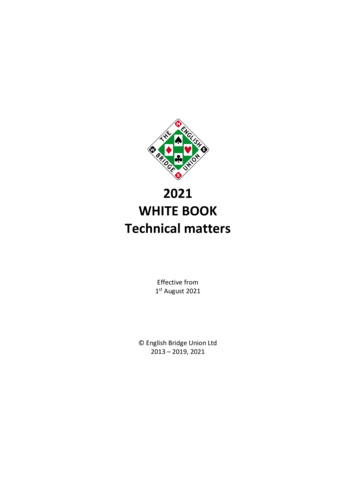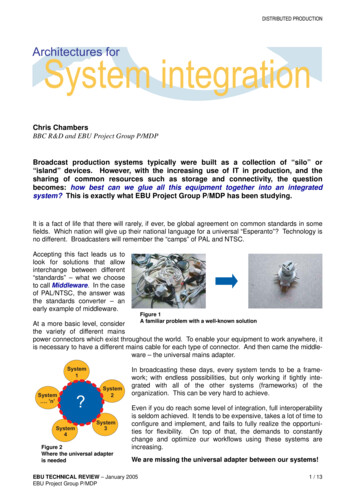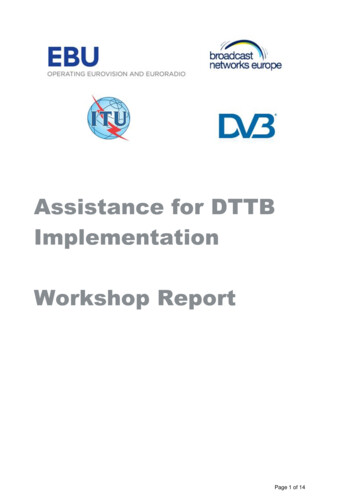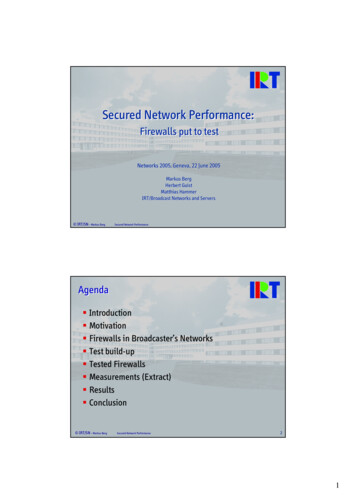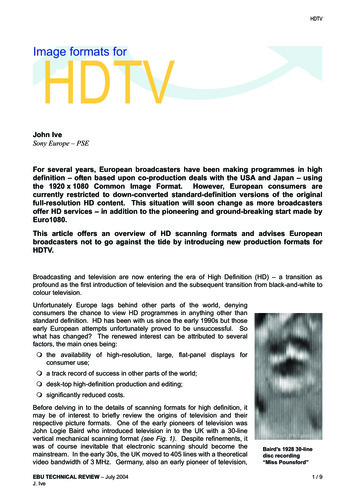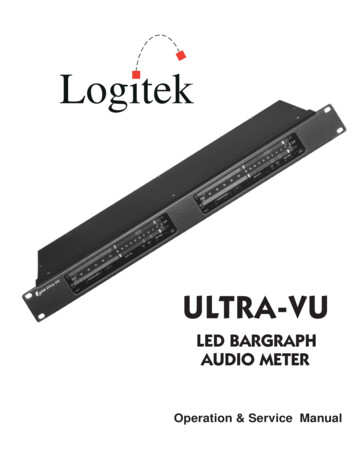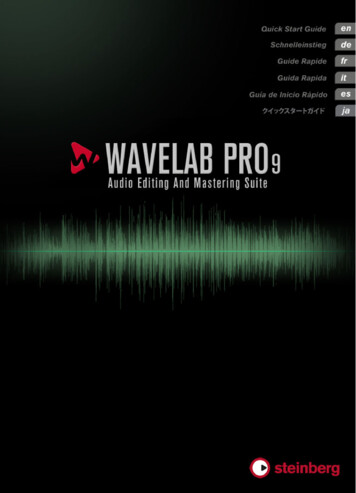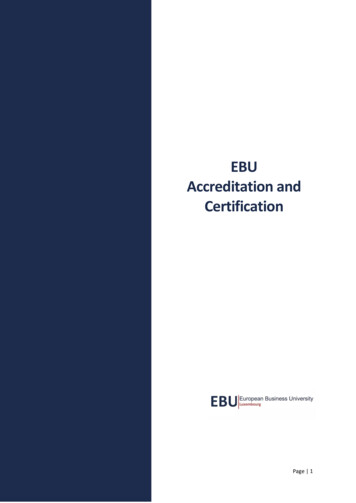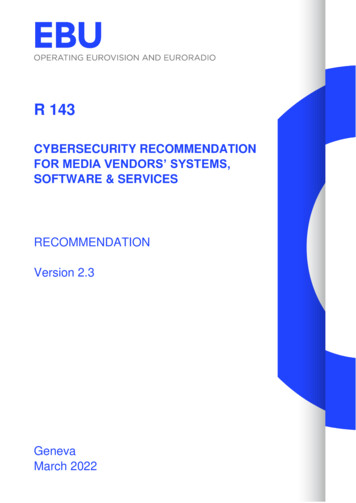
Transcription
R 143CYBERSECURITY RECOMMENDATIONFOR MEDIA VENDORS’ SYSTEMS,SOFTWARE & SERVICESRECOMMENDATIONVersion 2.3GenevaMarch 2022
This page is intentionally left blank.
R 143 v2.3Cybersecurity Rec. for media vendors’ systems, software & servicesCybersecurity Recommendationfor media vendors’ systems,software & servicesEBU CommitteeFirst IssuedRevisedTCMarch 201611/20, 04/21, 03/22Keywords:Re-issuedSecurity, Services, Infrastructure, Broadcasting, IP, Software, Application, Cyber,Security Controls Assertation, Vendor, Vulnerabilities, Authentication, Password,Encryption, Certificate, PKI, Keys, Log, Incident.RecommendationThe EBU, considering that1. Media companies increasingly employ third parties to provision their systems, software andservices.2. Production workflows and infrastructures are rapidly migrating to generic IT technologies.3. Cyberthreats (e.g., malware and ransomware) are increasingly easy to perform and arecontinuously evolving.4. Connected media devices still tend to have a low security threshold inherited from the era ofnon-connected broadcast media.Recommends that media companies:1. Apply the safety security safeguards set out in R 143 Security Controls Assertation1 and associatedguidance when planning and designing their systems, software and services.2. Require potential vendors of systems, software and services to declare their ability to complywith R 143 Security Controls Assertation (by completing columns A & B) and associated guidance,when responding to tenders or requests for technology. In this context, media companies canoptionally use column F to indicate their priorities with respect to individual requirements. Asuggested best practice prioritisation is provided in Column E, with the following categorization: “[P1]” designation represents critical provisions for the overall cyber security. “[P2]” designation recognizes important recommendations. “[P3]” designation represents best-practice arrangements.3. Define their minimal vendor system acceptance level based on this Recommendation with fullawareness of the potential risks.[Annex A, B & C & the Security Controls Assertion spreadsheet complete this Recommendation]1The Security Controls Assertation is a companion document to this publication. It is an Excel spreadsheet that may bedownloaded from the publication page of this Recommendation.3
Cybersecurity Rec. for media vendors’ systems, software & servicesR 143 v2.3Spreadsheet completion guidelinesDefinitionsProduct:The Product, service, system or software being provided by theOrganisation to the Customer.Organisation/Vendor:The potential Vendor (including appointed sub-contractors) providing theProduct, service, system or software.Customer:The entity that uses (purchases) a Product from your OrganisationThe sections in Annex A and Annex B correspond to the elements that must be completed in theSecurity Controls Assertation spreadsheet. Please read these Annexes carefully as they will assist youin correctly filling in the spreadsheet.Annex C reproduces the Security Controls Assertation spreadsheet for convenience of referencing.Entries in the Security Controls Assertation should be made in the Excel spreadsheet that may bedownloaded from the publication page of this Recommendation on the EBU technical website.4
R 143 v2.3Cybersecurity Rec. for media vendors’ systems, software & servicesAnnex A: Vendor Information Security Management SystemIS. Vendor ISMSIS-01 Cyber security policyA documented Cyber Security Policy (or set of policies) should be in place and approved by seniormanagement [P1]An information security policy is the foundation of an Organisation’s security programme. It shouldset out how the Organisation protects information assets, considering:Confidentiality: the protection of information from unauthorised access;Integrity: ensuring that information is complete and accurate and hasn’t been tampered with,altered or damaged in an unauthorised way;Availability: information is available to the right people when it is needed.The policy should be approved and signed off by senior management to demonstrate theircommitment to the Organisation’s security programme.Cyber security policies should be kept up to date and effectively communicated to all relevantpersonnel. [P1]Policies should be reviewed regularly to make sure that they are suitable, adequate and effective forthe Organisation.They should be communicated regularly to everyone that needs to see them. This should be in a waythat is relevant and understandable by the intended reader, and they should be easy to access.The Organization should be certified against recognised security standards and frameworks. [P2]There are a number of recognised cyber security frameworks and standards (including but not limitedto): ISO27001, National Institute of Standards & Technology (NIST), Cloud Security Alliance (CSA),European Union Agency for Cybersecurity (ENISA), Content Delivery & Security Association (CDSA),Motion Picture Association (MPA), and Bundesamt für Sicherheit in der Informationstechnik (BSI).If your Organisation is certified, you should provide evidence of the certification as part of thecompletion of the R 143 Security Controls Assertation.IS-02 Effective cyber security organisationAll cyber security roles and responsibilities should be assigned and communicated to relevantpersonnel. [P2]Cyber security roles and responsibilities should be assigned in line with the cyber security policy.There should be a named Chief Information Security Officer (CISO) or appointed person who hasoverall responsibility for cyber security within the Organisation. [P1]5
Cybersecurity Rec. for media vendors’ systems, software & servicesR 143 v2.3The CISO or appointed person should be of sufficient seniority within the Organisation and haverelevant expertise and experience to be able to carry out the role effectively.Cyber security awareness training and education should be provided to all employees (includingcontractors) as is relevant to their role. [P2]Training should include at a minimum: information protection and security, password and useraccount security, legal and regulatory (e.g. GDPR).IS-03 Audit planThe Organisation should have audit procedures in place that ensure periodic review of thesuitability and effective operation of its security controls framework. [P2]Regular reviews should be carried out to ensure that the Organisation's approach to cyber security iscontinually being assessed for its effectiveness and suitability and that any areas identified forimprovement or change are addressed.OS. Operational SecurityOS-01 Technical security analysisRegular technical security analysis such as penetration or vulnerability testing of the Product orservice should be performed. [P1]Vulnerability scans are automated tests that identify vulnerabilities in a system or application.Penetration testing is more in depth than a vulnerability scan and can be used to identify weaknessesas well as exploit them.System components, processes and software should be tested frequently to ensure that security ofCustomer information is maintained. This is especially important when significant changes are madeto infrastructure or internet-facing services.OS-02 Vulnerability managementA vulnerability management process should be in place to keep track of identified vulnerabilitiesand patches that may fix them. [P1]A vulnerability management process should be in place that demonstrates to customers howfrequently vulnerability testing is carried out and how patching is managed and implemented to fixany identified weaknesses.The process should ensure that potential vulnerabilities within the Product stack are identified (e.g.,if running an Oracle DB then Oracle security bulletins should be subscribed to) and there should be arelease process to patch security issues for Customers in line with this.There should be a vulnerability disclosure policy, or process in place for the responsible reportingof vulnerabilities. [P2]Having a vulnerability disclosure policy/process helps to reduce the risk of an incident occurring. Itallows a reasonable time for a Vendor to provide a vulnerability patch before it is publicly disclosed.6
R 143 v2.3Cybersecurity Rec. for media vendors’ systems, software & servicesIt is expected that a Vendor will comply with EBU R 160.The media vendor should release information immediately in the event any security vulnerabilityin its product(s) (own code or third-party code) becomes known. [P1]Reporting of vulnerabilities is covered in section IM. Incident Management.A Security Level Agreement should be put in place, which should include a specification of themaximum time to deliver patches to fix vulnerabilities, depending on their criticality and riskassociated to the Product when used by the Customer. [P1]OS-03 Product lifecycleThe Product lifecycle should be clearly defined, and patches and updates should be made availablethroughout that lifecycle, including for all third-party components embedded in Product. [P1]The Product or service lifecycle should be clearly defined so that the Customer is aware of key dates.Patches and updates should be made available to ensure that security can be maintained throughoutthe lifecycle of the Product or service, from implementation to decommission. The media vendorshall support the security updates for all third-party components used, including the operating systemplatform and runtime environments used.The Vendor should also support the upgrade of the software components of the system (OS, DBMS,Application Server etc.) if any of these components becomes unsupported.OS-04 Product/software deliveryA secure process should be in place for the delivery of products, software or services. [P2]The Vendor should provide physical and digital security controls for the delivery process of Products,software or services. These security controls may include: encrypted USB keys; Digitally signed files; delivery through secure protocols; encrypted software packages; and hash value checking.OS-05 Customer MaintenanceMaintenance and Remote support to Customers should be provided securely. [P1]If Customer support for the Product is done remotely, it should be provided securely, including, butnot limited to: Use of a Virtual Private Network (VPN) using multi-factor authentication (MFA). Ensuring that remote support accounts are only enabled for the duration of thetroubleshooting activity. All troubleshooting activity should be logged and reviewed.7
Cybersecurity Rec. for media vendors’ systems, software & servicesR 143 v2.3OS-06 Separation of Production and non-ProductionProduction and non-Production environments should be kept separate. [P2]Development, test and Production facilities should be separated to reduce the risk of unauthorisedaccess or changes to the operational environment.SD. Secure DevelopmentSD-01 Development lifecycleSecurity should be designed into and implemented through the whole lifecycle of Productdevelopment. [P2]There should be a policy or equivalent documentation in place which outlines the secure process forthe development of software or systems.The development lifecycle should include as a minimum: a risk assessment/threat modelling process; secure design/architecture review; documented secure coding guidelines and industry good practice (e.g., OWASP) that areapplied and kept up to date; mandatory test stages/security gates; secure code analysis where the source code and/or compiled versions of code are analysedto help find security flaws; and code cleaning to ensure that there is no test code remaining from the development processin the final version.SD-02 TrainingDevelopment staff should be trained in the latest secure coding principles and industry goodpractice. [P2]Development staff should receive regular training and continuous development to ensure they keepup to date with the latest secure coding principles and industry good practice.SD-03 Source-CodeAccess to proprietary program source-code should be restricted and is strictly controlled. [P2]Proprietary program source-code should be protected and access strictly controlled to preventintroducing unauthorised functionality, unintentional changes and to maintain confidentiality wherethere are intellectual property implications.8
R 143 v2.3Cybersecurity Rec. for media vendors’ systems, software & servicesIM. Incident ManagementIM-01 Incident responseA documented incident response and crisis management process/procedure should be in place,that is regularly reviewed and kept up to date. [P1]Security incident response responsibilities and procedures should be established to ensure a quick,effective and orderly response to information security incidents. This includes having a clear outlineof responses to different attack scenarios and clear escalation routes.The process should also include a post-incident review so that appropriate action can be taken toprevent the same or a similar security incident from reoccurring.IM-02 Contact pointsClearly appointed points of contact (internal, external, and at Customers) should be in place toensure a quick and effective response to security incidents. [P1])The list of contacts should consider the risk of people being unavailable (e.g., to have more than oneperson and contact method for each escalation point).The Organisation should have a 24/7 contact number available to respond to critical or significantinformation security incidents such as zero-day attacks, for example.A documented process should be in place to notify customers when a security incident occurs.[P1]The Organization should have a documented process in place that ensures that when the Organizationexperiences a security incident that could impact the Customer, notifications are sent in a timelymanner to Customer’s points of contact, with a short description of the incident and its criticalitylevel.IM-03 Forensic readinessA documented policy or process should be in place to manage the preservation of evidencerelating to security incidents. [P2]Documentation should be in place to preserve evidence for when disciplinary or legal proceedingsare required. This includes the collection, retention and presentation of such evidence.PS. Physical securityPS-01 Access controlPhysical access controls should be in place to restrict the entry and exit of personnel, equipmentand media from areas such as office buildings, data centres or rooms where communicationservers are located. [P1]The Organisation should ensure that any equipment and facilities are secured to prevent loss,damage, theft or compromise of Customer information. This includes: access control for entrances into the Organisation’s data centre (e.g. security guard, badgereader, electronic lock, court admissible CCTV) with logs recorded, reviewed and retainedas necessary;9
Cybersecurity Rec. for media vendors’ systems, software & servicesR 143 v2.3 physical access restricted to those with a business need and the minimum access necessaryto do their job; control of delivery and loading areas and other points of access where unauthorised personscould enter the premises; emergency exit doors should be alarmed, monitored and tested in line with appropriateregional, national and international standards; power supplies and fire safety mechanisms undergo regular maintenance checks and complywith Health and Safety regulations; and intruder detection systems should be installed, monitored and tested in line withappropriate regional, national and international standards.PS-02 Environmental threatsPhysical protection should be in place to reduce the risk from environmental threats and hazardsas well as deliberate attack. [P2]Environmental threats should be considered, and the risk assessed, especially when delivering aService. This includes threats such as flood, fire, earthquake, civil unrest and other forms of naturalor man-made disaster. Specialist advice may be needed to ensure that there is adequate protectionin place.CS. Cloud SecurityCS-01 Cloud-based service adoption procedureVendors should provide all information needed by Customer to follow the cloud adoptionprocedure defined in EBU R 146. [P2]Recommendation R 146 provides a procedure for the acceptance of cloud-based services by mediacompanies. The Vendor should cooperate and provide all information needed by the media companyto follow the procedure, including service functionalities, processes, systems and data, dataclassification, possible usage limitations according to local or European laws, technical andorganizational requirements to operate the service etc.CS-02 Segregation of Customer dataAppropriate segregation of Customer data should be in place. Customer data should be stored orprocessed in a multi-tenanted environment. [P1]If Customer data is hosted on cloud platforms where there are multiple tenants, there should besegregation between Customers so that each Customer’s data are kept confidential and are notdisclosed to the other Customers and that an incident affecting one Customer does not have anadverse impact on other Customers or their information.CS-03 Segregation of Customer platforms/infrastructureAdequate segregation should exist between Customer platforms and infrastructure to allowupdates or changes to be applied independently, where required. [P1]10
R 143 v2.3Cybersecurity Rec. for media vendors’ systems, software & servicesAs in section CS-02, there should be segregation between Customers to ensure that if an update orchange needs to be applied independently to one Customer, there is no adverse impact to otherCustomers.BC. Business ContinuityBC-01 Business continuity planningA business continuity and/or disaster recovery plan should be in place that is tested and reviewedat regular intervals. [P2]The Organisation should have a business continuity or disaster recovery plan in place that includesthe continuation of security of Customer information in the event of an adverse situation.As a minimum, the plan should: set out how business operations will be restored following an interruption to or failure ofbusiness processes within an agreed time period (agreed with the Customer); set out how information security will be maintained; include arrangements to inform and engage the appropriate Customer personnel in itsexecution; be tested at regular intervals; be regularly reviewed and updated where necessary.In case the Product is a service provided to the Customer, there should be sufficient redundancy tomeet the availability requirements for providing the services to the Customer.BC-02 Utility Service OutagesSecurity measures should be in place to protect Customer Information in case of utility serviceoutages (e.g., power failures and network disruptions). [P2]Security measures should be in place to protect Customer information and could include (but is notlimited to): backup power generation; dual/multiple routing; load balancing and redundancy; bandwidth capacity monitoring and alerting; andregular testing.11
Cybersecurity Rec. for media vendors’ systems, software & servicesR 143 v2.3SC. Supply Chain ManagementSC-01 Supply chain security control assessmentThe Vendor should apply the same level of security control assessment procedure to its ownsuppliers and subcontractors. [P1]The Vendor should require its own potential subcontractors, Suppliers and Vendors of mainsubsystems, software and services that are embedded in their Products to declare their ability tocomply with security controls assertation and guidance with the same level of details provided in thisRecommendation. Vendors should communicate the results to their Customers.CM. Change managementCM-01 Change managementChanges that affect the security of the Product or service should be controlled and authorisedthrough a formal, documented process. [P3]Changes that affect the security of the Product or service should be controlled, documented, andauthorised through a formal process. Any such change must be reviewed and tested to ensure thatthere is no adverse impact on the Product provided to the Customer or to the security of Customerinformation.12
R 143 v2.3Cybersecurity Rec. for media vendors’ systems, software & servicesAnnex B: Product Security RequirementDO. DocumentationDO-01 Password changeThere should be explicit instructions to change default passwords, especially in internet facingsystems. [P1]Default passwords are a well-known vulnerability. The documentation issued with the Product shouldhave explicit instructions to change default passwords.DO-02 Security functionalityProduct documentation should include a complete description of security functionality. [P2]Documentation provided should include details of all the security functionality provided with theProduct. This should cover all the requirements in Annex B of this Recommendation as a minimum.DO-03 NetworkingProduct documentation should include a complete description of interfaces, access points,network communication and features. [P1]In detail, the Vendor should provide: which Layer 3 capabilities are used; which ports are used by the application/system; which IP ports are open (not used, but could potentially be used for application attack); and which IP ports are disabled as part of the standard application configuration.DO-04 IntegrationProduct documentation should include information on how to integrate the Product in a securityframework (e.g., different network zones, central authentication service, workflows, interfaces,only necessary TCP/UDP ports are open). [P2]Clear documentation should be provided that includes detail on how to integrate the Product invarious security scenarios.DO-05 HardeningThe Product should include recommendations on hardening or best practice configuration,including the default state of the Product. Only the minimum required services should be active.[P1]Where available, industry best practice should be followed for system hardening e.g. CIS Benchmarksor SANS Institute.13
Cybersecurity Rec. for media vendors’ systems, software & servicesR 143 v2.3Only the minimum required services should be running.DO-06 Patch management processProduct documentation should include a description of the patch and release managementprocess (especially regarding security updates). [P1]The patch management and release management documents for the Product should be produced inline with section OS-O3 Product lifecycle.AA. Authentication & AuthorisationAA-01 Central authenticationThe Product should support central authentication services that are most used in the industry.[P2]The Product should support central authentication services. The following is a list of those that aremost used in the industry: Active Directory: Kerberos based authentication LDAP over SSL: LDAPS Identity Provider: SAML IdP: Simple Authentication Mark-up Language OpenID IdP: Identity layer on top of the OAuth protocol RADIUS TACACS AA-02 Session timeoutThe Product should support the timeout of sessions. [P2]Session timeouts should be set with a balance of security and usability. The window of opportunityfor an attacker needs to be limited, but a user should be able to comfortably complete operationswithin the Product without the session timing out too often.AA-03 Role based access control (RBAC)The Product should support RBAC. [P2]Role based access restricts access based on a user’s role within an Organisation.The access to the product or service should only be granted for particular capabilities, roles, or usersand is not available to anyone. The product or service should deny access by default when delivered.14
R 143 v2.3Cybersecurity Rec. for media vendors’ systems, software & servicesAA-04 Personalised accountsThe Product should support the authentication of individual users. [P2]Every user should log into the system with a unique personal account to ensure that the individualactivity of each person using the account can be identified and audited, and that individualaccountability is maintained.AA-05 Default passwordsThe Product should require user to change default passwords for built-in accounts. [P1]It should be mandatory to change default passwords. As factory or default passwords are often wellknow and publicly documented, they could be a source of unauthorised access, especially forequipment that is exposed to the internet.The Product should not have global hidden accounts with the same password or access key forall Product units and Customers. [P1]Products often embed “hidden” accounts, used by Vendors to perform maintenance tasks (whichmeans that these accounts have high privileges.AA-06 Password policyThe Product should support a strong password policy implementation. [P1]To implement strong passwords, the password policy should include as a minimum: Minimum password length of 10 characters (longer for administrative accounts, 15characters are recommended). Upper/lowercase characters. Numbers. Special characters and extended special characters.AA-07 AuthenticationThe Product should support enhanced authentication mechanisms such as multi-factorauthentication (MFA), in internet-facing interfaces or for internet-facing services [P1]Strong authentication mechanisms provide additional layers of security to the traditionalauthentication scheme. The strong authentication method relies on implementing more than one ofthe following authentication factors (Multi-Factor Authentication – MFA):1. Something you know2. Something you have3. Something you areFor example, using an authenticator App on a trusted device, a physical security token or a one-timepassword/code that is regularly refreshed or with a short expiry.The Product should support enhanced authentication mechanisms (second factor of authentication(2FA) using Security Assertion Mark-up Language V2 (SAML2)) in internet-facing interfaces. This15
Cybersecurity Rec. for media vendors’ systems, software & servicesR 143 v2.3method can be combined with SSO, allowing users to authenticate only once, and not for eachapplication they access.AA-08 Authentication, Authorisation and Accounting (AAA) loggingThe Product should generate logs for authentication events, authorisation events and useractivities as they occur. [P1]The Product should generate security event logs that record details of: Authentication: details of any logins to the system and whether they were successes orfailures. Authorisation: details of user attempts to access specific system functions (especiallysensitive administrative functions) and whether these were permitted or denied. Accounting: details of activities / actions undertaken by users on the system.See also: BA-01 for recommendations on how to manage logs generated.EN. EncryptionEN-01 Password storage and transferPasswords should neither be stored in the Product nor transferred in plain text or in anyreversible format. Onscreen password masking should be implemented. [P1]The Product should implement onscreen password masking i.e., when typing in a password, thesystem displays a row of asterisks rather than an actual password. This ensures that the entry of userpasswords cannot be observed by another user.EN-02 Data at restThe Product should support state-of-the-art encryption technologies following industry bestpractice recommendations and latest standards. [P2]Data at rest should be encrypted using state-of-the-art encryption, following common standards likeNIST FIPS 140-3, BSI TR-02102-1 etc. It should be documented which standards the product or serviceuses.EN-03 Data in transitThe Product should support authenticated and encrypted network protocols. [P1]Communications should be authenticated and encrypted when transmitted across networks so as toprotect against tampering and eavesdropping of network traffic by unauthorized users, followingcommon standards like BSI TR-02102 series or NIST SP 800-52 Rev.2 etc. It should be documentedwhich standards the product or service uses.16
R 143 v2.3Cybersecurity Rec. for media vendors’ systems, software & services The following protocols should be used: HTTPS SFTP FTPS SCP SSHv2 SNMPv3 The following protocols should be avoided: HTTP FTP TELNET SNMPv1 - SNMPv2 SSHv1 VNCEN-04 Certificates ManagementCertificates should be securely managed, and regularly renewed. [P2])Certificates are necessary to authenticate people, devices and services and to secure the transfer ofinformation. Certificate management should follow common standards. It should be documentedwhich standard the product or service uses.EN-05 Cryptographic keys ManagementCryptographic keys should be securely managed. [P1]Every encryption-based system has a default master key that encrypts all the private keys andpasswords in the configuration to secure them. It is recommended to: Configure a new master key instead of using the default. Change it periodically (the time-period depends on factors such as the criticality/sensitivityof the data being protected). Store it in a safe location.Information on how to configure and potentially reset the master key might also need to be providedby the Vendor.BA. Base configurationBA-01 Log managementThe Product should generate security event and error logs. [P1]The Product should, as a minimum, generate the following types of log: Security events: the system should log AAA data in accordance with AA-08.17
Cybersecurity Rec. for media vendors’ systems, software & services R 143 v2.3Errors: the system should generate error logs when something has gone wrong.The Product should provide capabilities for securely delivering logs in sync to a centralised logmanagement platform. [P1]The Product should support regular time synchronisation (e.g., using NTP) with the agreed commonreference time-source used by the Organisation deploying it. The investigation of issues is challengingif systems on a network do not use the same time-source.The Product sho
A vulnerability management process should be in place to keep track of identified vulnerabilities . release process to patch security issues for Customers in line with this. . Link to Incident Management section in this document. Cybersecurity Rec. for media vendors' syst. ems, software & services R 143 v2.3 .
